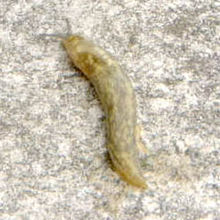| Limacus maculatus | |
|---|---|

| |
| Scientific classification | |
| Domain: | Eukaryota |
| Kingdom: | Animalia |
| Phylum: | Mollusca |
| Class: | Gastropoda |
| Order: | Stylommatophora |
| Family: | Limacidae |
| Genus: | Limacus |
| Species: | L. maculatus
|
| Binomial name | |
| Limacus maculatus (Kaleniczenko, 1851)
| |
| Synonyms | |
|
Krynickillus maculatus Kaleniczenko, 1851 | |
Limacus maculatus, the green cellar slug or Irish yellow slug, is a species of slug native to the Caucasus and Black Sea coast.[2] It has also been introduced to a number of northern European countries. In its introduced range the species is often synanthropic. It is most likely to be confused with Limacus flavus, which it closely resembles externally.
Limax ecarinatus Boettger, 1881 is the appropriate name if Limacus is considered a subgenus of Limax.[3] The reason is that Nunneley already described a Limax maculatus in 1837; this turned out to be a synonym of Limax maximus, but nevertheless the combination Limax maculatus cannot be re-applied to a species described under the name maculatus at a later date (even though that 1851 description used a different genus, Krynickillus).

- ^ MolluscaBase eds. (2021). "Molluscabase. Limacus maculatus (Kaleniczenko, 1851)". www.molluscabase.org.
- ^ Wiktor, A.; Norris, A. (1982). "The synonymy of Limax maculatus (Kaleniczenko 1851) with notes on its European distribution". Journal of Conchology. 31: 75–77.
- ^ Welter-Schultes, F.W. (2013). Guidelines for the capture and management of digital zoological names information. Version 1.1. Copenhagen: Global Biodiversity Information Facility. p. 65. ISBN 978-87-92020-44-4.
- ^ Boettger, O. (1881). "Boettger, O. (1881). Sechstes Verzeichniss transkaukasischer, armenischer und nordpersischer Mollusken aus Sendungen der Herren Hans Leder, z. Z. in Kutais und Dr. G. Sievers in St. Petersburg". Jahrbücher der Deutschen Malakozoologischen Gesellschaft. 8 (3): 167–261, pl. 7–9.